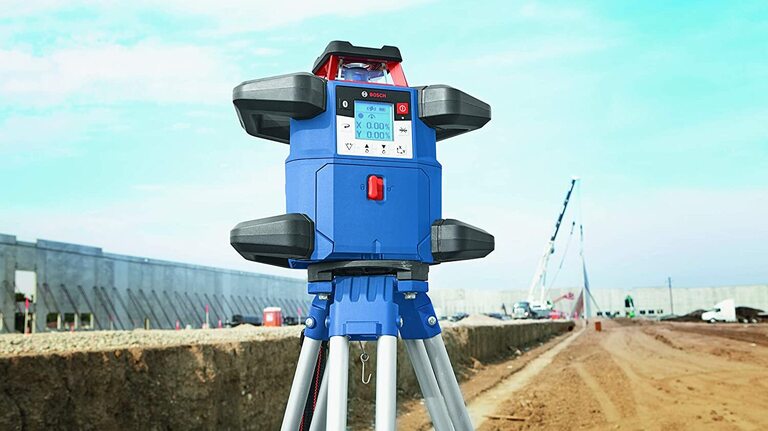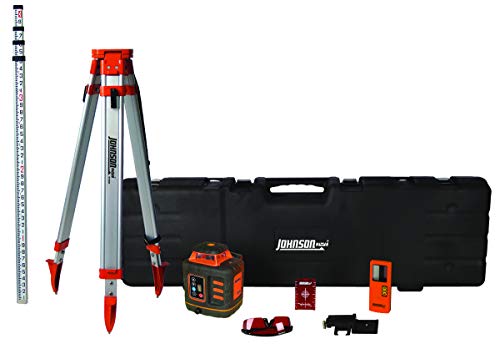Best Laser Level For Grading And Drainage Of 2024
Brandon Forder Apr 20, 2024 7:59 AM
If you need to measure something across a large area or a long distance with pinpoint precision, a rotary laser level is an indispensable instrument. Pros and amateurs alike utilize levels on a wide variety of surfaces, including those with slopes or grades, to plan and lay out projects, as well as for basic construction, landscaping, and excavation.
Many different functions can be found on rotary laser levels, making them a potentially difficult equipment to use. It can be difficult to find the optimal setting, especially for newcomers. Our in-depth analysis of precision tools compares and contrasts them to the competition, and we provide several recommendations for the most useful rotary laser levels.

Compare Products
- SCORE9.0
- BrandJohnson
- Prime
- SCORE9.0
- BrandJohnson
- Prime
- SCORE8.8
- BrandJohnson
- Prime
- SCORE8.0
- BrandDEWALT
- Prime
Last update on 2024-04-20 / Affiliate links / Images, Product Titles, and Product Highlights from Amazon Product Advertising API
Accuracy and Range
Any laser used for measuring or leveling will have an accuracy specified in terms of a fraction of an inch over a specified distance. Each number needs to be taken into consideration. If you're looking for a rotating laser level, one that advertises an accuracy of 1/8 inch over 100 feet is far preferable to one that quotes the same precision over a range of 50 feet, for example. However, the latter option may end up being more suitable, and cheaper, for the task at hand. Direct comparisons may involve some simple arithmetic if two manufacturers provide you different units of measurement, such as 3/32 inch over 30 meters.
The alternatives for high-quality rotary laser levels are extensive. We found that the shortest beam distance was 600 feet, while the longest was 2,600 feet, or almost half a mile. However, range is of little use if it cannot be accurately used. A low-end rotary laser level with an accuracy rating of 14 inch over 50 feet will be off by nearly 10 feet at 2,000 feet, whereas a high-end device will be out by only about 212 inches.
Beam Quality and Adjustments
An important consideration is how obvious the laser is. The light from a green laser is often easier to spot than that from a red laser. Since green lasers are far more expensive overall, the majority of rotary laser levels only emit a red beam.
A rotary laser level can be used either indoors or outdoors, depending on the model. With increased distance, the red beam becomes less visible. Red-lensed spectacles, which are usually provided, greatly improve visibility. Beam receivers or detectors are utilized for transmission across great distances. Such devices are often installed on a tripod and feature an audible beep to signal when they are properly aligned with the aimed beam.
The rate of rotation of the laser is another crucial factor. As it spins, the laser rarely stays fixed in one place for more than a fraction of a second. Since the beam does not project a solid line, it can be difficult to tile or fit wainscot or trim indoors, although it is usually not a problem when leveling outdoors, grading, sitting posts, etc. If the speed is raised, however, the beam remains in touch with the surface for a longer period of time, creating the illusion of a continuous line. This feature is available on many rotational level lasers, making them a more flexible choice of equipment.
Self-Leveling
All readings from a rotating laser will be off if the device isn't level to begin with. Manual setting with a bubble, like that of a normal level, is occasionally required with inexpensive rotating laser levels. While relying solely on sight may not impair accuracy at close ranges, it may greatly amplify errors over longer distances.
Both manually and automatically activated self-leveling functions are available on self-leveling models. The former is practical for when an angled beam is needed. Again, precision is crucial, and most will self-level to within 5 degrees. Self-leveling rotating laser levels have the great benefit of self-correcting if they are bumped. In the case of other forms, regular inspection is necessary to prevent errors from going undetected.
Beam Orientation
It indicates the path that the laser level will make when it projects a line. There are three different orientations for a line projection: vertical, horizontal, and spherical (where a horizontal line projected on all four walls). All these features can be found on most high-end laser levels. Laser levels can be purchased at a reasonable price, although the cheapest ones only have two beam orientations.
Red Vs Green
Laser color has a profound effect despite its apparent simplicity. They come in either a green or a red color option. It's important to remember that every color comes with its own set of advantages and disadvantages.
Red lasers have lower power output but utilize less power during operation. This is a choice in cheaper options as well. The majority of their usefulness lies within the confines of a building.
High-intensity green lasers are capable of projecting light that can be seen from great distances. This makes it better suited for usage outdoors, particularly in direct sunshine, than indoors. However, they are more expensive, drain batteries faster, and may cause permanent eye damage than red lasers.
Bottom line: red beam is better if your work is mostly done inside. Green beam lasers are ideal if your work mostly entails high-end outdoor projects.
Mounting Options
There are several benefits to utilizing a laser level, but one of the best is that you can use it without having to hold it. Once it's in place, they can be left alone to focus on other parts of the project that will use it as a benchmark.
The best laser levels typically provide a variety of mounting options and features to facilitate "set it and forget it" use. Some of the more inexpensive choices may merely use small pegs to anchor into drywall. While some may come with tripods or mounts with metal studs or drop ceiling tracks. You should think about the mounting accessories you'll need and how you'll be using the laser level before you buy it.
Beam Type – Horizontal or Dual
There are two different kinds of beam that laser levels can produce: horizontal and dual. Where you put the laser level affects how you use them. If, for instance, you spend most of your time leveling floors, a horizontal laser will help you pinpoint any imperfections quickly and accurately.
Dual-beam lasers are often more expensive but can provide additional benefits. It simultaneously emits two beams, one in the horizontal and one in the vertical. They work well in settings where there will be a lot of walls and partitions. Cabinetry installation is another possible application.
Warranty
A laser level is primarily a stationary tool, but it is still employed on building sites. As a result, your laser level may be subjected to a great deal of abuse over time, which can significantly reduce its lifespan. The problems that can occur from this are serious enough that it may stop working after a certain period of time.
Accordingly, it is crucial to investigate the guarantee provided by any laser level you're considering purchasing. You can rely on the durability of whichever model you choose, since nearly all of them are covered by a minimum 2-year warranty. However, for your peace of mind, dependable models may come with a 3-year warranty.
What Is Grading?
It's important that you understand what "grading land" entails before we discuss which laser level is ideal for this task. Landscape grading, also known as just grading, is the process of shaping and leveling terrain. To grade a piece of land is to assess its slope, levelness, and flatness, and then adjust its slope or levelness to meet a particular requirement.
Landscape grading is the process of leveling and shaping an outside area in preparation for the installation of features such as hardscaping walks, landscaping features, patios, steps, pools, sheds, and structures. Changing the slope and elevation of land to make it more suitable for building or farming is what grading is all about. In addition, when constructing a home, remember that a 10% slope should be constructed for the first four feet around all of the walls to ensure proper drainage.
What Type of Laser Level Works Best for Grading?
What you need to realize is that there are various kinds of laser levels available to you. To be more specific, four distinct categories can be distinguished. There are many different types of laser levels, such as the dot laser level, line laser level, rotary laser level, and combination laser level.
In no way, shape, or form should a dot laser level be used for landscape grading. Dot laser levels only emit a single point of light, hence they require a flat surface, such as a wall, to be used effectively.
For all intents and purposes, a line laser level might be used to grade a landscape. The problem is that line laser levels can only project a single line in one direction. But if you're just leveling off a narrow strip of ground along a straight line, a line laser level would be adequate.
However, a laser level that can see or shoot in any direction is essential for land grading. Whether it's green or red makes little difference. With that in mind, the rotary laser level is the best tool to use when determining the gradation of the land, as well as what needs to be done to get the land in the proper shape for whatever is to be built upon it, whether we're talking about agricultural land surveys, preparing farmland, leveling land for apartments and condos, or building a house or a small shed.
Should I get a tripod when using a rotary laser level?
The use of tripods is crucial for sustained precision. If you're having trouble finding a level surface on which to rest your rotary laser level, a tripod can provide a firm base in any situation.
Are all rotary laser levels waterproof?
No. Some are completely impervious to water, while others may withstand a light rain or splash. You should check the rotating laser level's IP (ingress protection) rating to make sure it's watertight; an IP67 rating, for instance, is ideal. The first number indicates how well it repels dust, while the second number describes how well it does the same for water.
What is the difference between red and green rotary laser levels?
Red rotary laser levels, on average and depending on the manufacturer, are less expensive and have a longer battery life. Green rotary laser levels are not widely used because of the high price tag.
So, there you have it: a quick and easy tutorial on how to choose the right laser level for grading and drainage.
It may sound complicated, but with some study, you'll be an expert in no time.


























